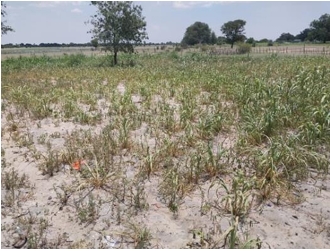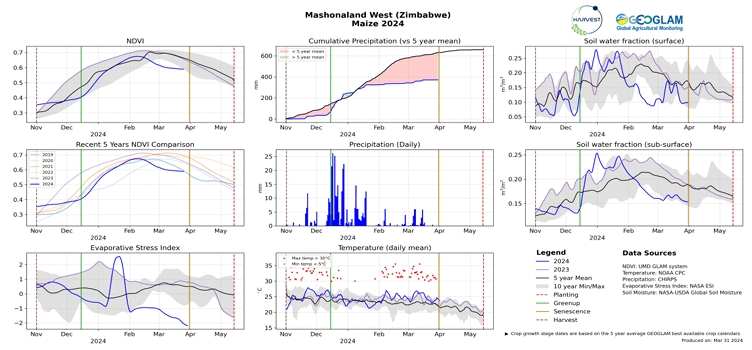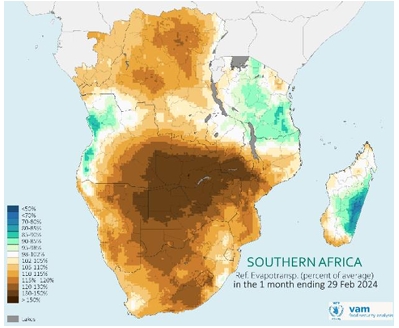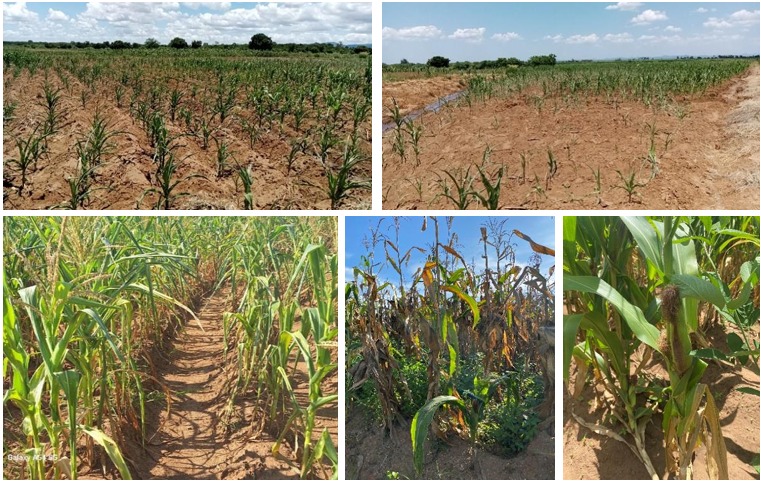GEOGLAM Crop Monitor for Early Warning Releases a Special Alert on Southern Africa El Niño induced drought

The 2023/2024 El Niño brought severe below average and erratic rains over Southern Africa for the main cropping season. In addition to a delayed start, poor rains and high temperatures, a record-breaking mid-season dry spell of over 50 days from late January through the start of March impacted much of the central and south of the region during key developmental stages and resulted in crop failure in these areas. Some central parts of the region received the lowest February rainfall, potentially in the last 100 years. This has resulted in below average to failed harvests across much of the region and States of Emergency have been declared across Zambia, Zimbabwe and Malawi. Critical monitoring is needed in the coming months to continue to assess El Niño impacts on agricultural production and food security in the region. The GEOGLAM Crop Monitor for Early Warning Initiative monitors crop conditions over countries at risk of food insecurity in partnership with the major global agriculture and food security monitoring agencies including FAO, WFP, FEWSNET, JRC, Asia Rice, among others. This community gathers on a monthly basis to discuss and build consensus around global crop conditions and presents this in a monthly bulletin.
In the April CM4EW bulletin, a Special Alert on Southern Africa was released outlining the current situation and the El Niño induced drought which has impacted agricultural production across much of the region.
See the GEOGLAM Crop Monitor for Early Warning April Special Alert:
El Niño-induced record dry spell threatens agricultural production outcomes across Southern Africa and raises concerns for food security
Forecasts leading up to the main October to December rainfall season in Southern Africa indicated a high likelihood for above-average temperatures, delayed rainfall onset, and generally below-average precipitation influenced by factors like El Niño and a positive IOD. The potential for below-average cropping outcomes was warned of as early as August 2023 in the Crop Monitor Special Alert on El Niño.
This forecast has materialized across much of the region with poor to failed crop yields. Official declarations of disaster regarding the extreme drought have been raised across Zambia, Zimbabwe, and Malawi, and no recovery is expected across worst affected areas at this stage of the season.
The 2023/24 main cropping season in Southern Africa began in late October with limited and erratic rains in southern areas. While planting activities picked up in November, a dry spell following the false rainfall start contributed to the failure of sowing efforts.
Generally dry and hot conditions in November and early December in central and western areas contributed to crop wilting, a shortened agricultural season, and a reduction of the planted area.

Planting activities became delayed until December as some areas were still contending with lingering dry conditions from the previous season and a delayed rainfall onset for the current season. As a result, crop conditions began to degrade. Conversely, a shift to above-average rains in mid-December through mid-January resulted in some localized flooding but prompted enhanced agricultural activities, including planting and replanting efforts, application of agricultural inputs, and weeding across the north and central areas.
Despite the improved rains, dry conditions returned in early to mid-January as crops entered the vegetative to reproductive stage, and seasonal rainfall totals were below-average across most central and western areas. Additionally, elevated temperatures indirectly affected crops by exacerbating the dry conditions.
As outlined in the March 24 CHC blog post, a record-breaking mid-season dry spell of over 50 days from late January through early March impacted several areas of the region during the key developmental stages, culminating in the lowest rainfall received for the late January to February timeframe in the last 40 years for many central areas of the region. Many areas across Southern Africa received half or less of typical rainfall amounts, including parts of Angola, Namibia (Figure 1), Zambia, Zimbabwe (Figure 2), and Botswana. Additionally, some central areas recorded the lowest February rainfall in 100 years.

The severe and prolonged dry spell from late January to February came at a time when seasonal rains would typically be nearing their peak, resulting in permanent crop wilting in parts of Zambia, Zimbabwe, Malawi (Figure 4), and Mozambique as well as the declaration of national disasters regarding the extreme drought in Zambia, Zimbabwe, and Malawi.
The situation was driven by both a considerable rainfall deficit as well as an increase in water demand, likely influenced by high temperatures that increase atmospheric evaporative demand, imposing severe water stress on crops (Figure 3). During the dry spell, daytime maximum temperatures were much higher than average across the region and surpassed maize heat tolerance levels in many areas.

Outlook
Forecast rainfall through June is expected to be below-average in most central and southern areas of the region with a likely severe negative impact to the remainder of the cropping season and little chance of recovery. Regions that experienced dry conditions and below-average yield outcomes in the previous season, including southern Angola, northern Namibia, Botswana, parts of Zambia, and southern Malawi are particularly vulnerable and will need to be monitored closely.


To find out more about the GEOGLAM Crop Monitor Initiative and to sign up to the mailing list and receive the monthly bulletins visit www.cropmonitor.org